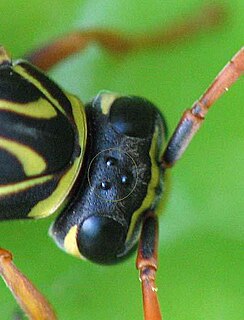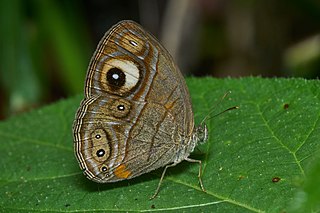This page is based on this
Wikipedia article Text is available under the
CC BY-SA 4.0 license; additional terms may apply.
Images, videos and audio are available under their respective licenses.

The California two-spot octopus, often simply called a "bimac", is an octopus species native to many parts of the Pacific Ocean including the coast of California. One can identify the species by the circular blue eyespots on each side of its head. Bimacs usually live to be about two years old. They are closely related to Verrill's two-spot octopus. In 2015, the genome was sequenced.

A simple eye refers to a type of eye form or optical arrangement that contains a single lens. A "simple eye" is so called in distinction from a multi-lensed "compound eye", and is not necessarily at all simple in the usual sense of the word. The eyes of humans and large animals, and camera lenses are classed as "simple" because in both cases a single lens collects and focuses light onto the retina or film. Many insects have compound eyes consisting of multiple lenses, each focusing light onto a small number of retinula cells.

Mycalesis patnia, the glad-eye bushbrown, is a satyrid butterfly found in southern India and Sri Lanka.
Ichthyology uses several terms that are unique to the science.

Daphnis nerii, the oleander hawk-moth or army green moth, is a moth of the family Sphingidae. It was described by Carl Linnaeus in his 1758 10th edition of Systema Naturae.

Smerinthus ocellatus, the eyed hawk-moth, is a European moth of the family Sphingidae. The species was first described by Carl Linnaeus in his 1758 10th edition of Systema Naturae.

Amphiesmenoptera is an insect superorder, established by S. G. Kiriakoff, but often credited to Willi Hennig in his revision of insect taxonomy for two sister orders: Lepidoptera and Trichoptera (caddisflies). In 2017, a third fossil order was added to the group, the Tarachoptera.

Junonia almana, the peacock pansy, is a species of nymphalid butterfly found in South Asia. It exists in two distinct adult forms, which differ chiefly in the patterns on the underside of the wings; the dry-season form has few markings, while the wet-season form has additional eyespots and lines.It is listed as Least Concern in the IUCN Red List.
Photoreceptor can refer to:
Parnassius przewalskii is a high-altitude butterfly which is found in Tibet and west China.
It is a member of the snow Apollo genus (Parnassius) of the swallowtail family (Papilionidae).

Dictyopharidae is a family of bugs in the suborder Auchenorrhyncha belonging to the infraorder Fulgoromorpha. The family comprises nearly 760 species in more than 150 genera.

Glaucopsyche melanops, the black-eyed blue, is a butterfly of the family Lycaenidae. It is found in the western part of Southern Europe and North Africa.

Apposition eyes are the most common form of eye, and are presumably the ancestral form of compound eye. They are found in all arthropod groups, although they may have evolved more than once within this phylum.
Some annelids and bivalves also have apposition eyes. They are also possessed by Limulus, the horseshoe crab, and there are suggestions that other chelicerates developed their simple eyes by reduction from a compound starting point. Some caterpillars appear to have evolved compound eyes from simple eyes in the opposite fashion.
Orthodenticle is a homeobox gene involved in Drosophila head development. It produces a homeodomain protein which controls the development of cells in the developing head of embryos. It defines the midline of the head, and is involved in the formation of the top side of the head, including the eyes.
The pigment spot ocellus is an ocellus that contains only part of its cells pigmented. It is characteristic of jellyfish, sea stars, and flatworms.
Blennophis anguillaris, the snaky klipfish, is a species of clinid found in the subtropical waters of the Atlantic Ocean around South Africa. It can be found in the subtidal zone and also is a denizen of tidepools. This species can reach a maximum length of 30 centimetres (12 in) TL.

Junonia orithya is a nymphalid butterfly with many subspecies occurring from Africa, through southern and south-eastern Asia, and in Australia. In India, its common English name is the blue pansy, but in southern Africa it is known as the eyed pansy as the name blue pansy refers to Junonia oenone. In Australia, this butterfly is known as the blue argus, but this name also is used for the Aricia anteros in Europe.

Aphantopus arvensis is a butterfly found in the Palearctic that belongs to the browns
family. It is endemic to China

Callerebia dibangensis, the Roy’s argus or bright-eyed argus is a species of Satyrinae butterfly found in eastern Himalaya, India.














